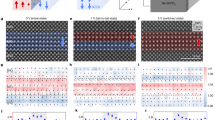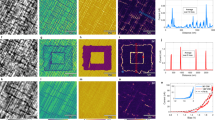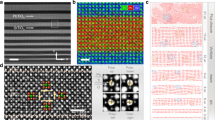Abstract
Charged domain walls in ferroelectrics exhibit a quasi-two-dimensional conduction path coupled to the surrounding polarization. They have been proposed for use as non-volatile memory with non-destructive operation and ultralow energy consumption. Yet the evolution of domain walls during polarization switching makes it challenging to control their location and conductance precisely, a prerequisite for controlled read–write schemes and for integration in scalable memory devices. Here, we explore and reversibly switch the polarization of square BiFeO3 nanoislands in a self-assembled array. Each island confines cross-shaped, charged domain walls in a centre-type domain. Electrostatic and geometric boundary conditions induce two stable domain configurations: centre-convergent and centre-divergent. We switch the polarization deterministically back and forth between these two states, which alters the domain wall conductance by three orders of magnitude, while the position of the domain wall remains static because of its confinement within the BiFeO3 islands.
This is a preview of subscription content, access via your institution
Access options
Access Nature and 54 other Nature Portfolio journals
Get Nature+, our best-value online-access subscription
$29.99 / 30 days
cancel any time
Subscribe to this journal
Receive 12 print issues and online access
$259.00 per year
only $21.58 per issue
Buy this article
- Purchase on Springer Link
- Instant access to full article PDF
Prices may be subject to local taxes which are calculated during checkout





Similar content being viewed by others
Change history
31 July 2018
In the version of this Article originally published, the corresponding author names in the author list appeared in the reverse order; they should have read ‘Jinxing Zhang and Ce-Wan Nan’. The order of these authors’ initials in the ‘Correspondence and requests for materials’ statement were similarly affected. These errors have now been corrected in all versions of the Article.
References
Mermin, N. D. The topological theory of defects in ordered media. Rev. Mod. Phys. 51, 591–648 (1979).
Seidel, J. (ed.) Topological Structures in Ferroic Materials (Springer, Cham, 2016).
Catalan, G., Seidel, J., Ramesh, R. & Scott, J. F. Domain wall nanoelectronics. Rev. Mod. Phys. 84, 119–156 (2012).
Hang, F. T. & Cheong, S. W. Aperiodic topological order in the domain configurations of functional materials. Nat. Rev. Mater. 2, 17004 (2017).
Vasudevan, R. K. et al. Domain wall conduction and polarization-mediated transport in ferroelectrics. Adv. Funct. Mater. 23, 2592–2616 (2013).
Tang, Y. L. et al. Observation of a periodic array of flux-closure quadrants in strained ferroelectric PbTiO3 films. Science 348, 547–551 (2015).
Yadav, A. K. et al. Observation of polar vortices in oxide superlattices. Nature 530, 198–201 (2016).
Damodaran, A. R. et al. Phase coexistence and electric-field control of toroidal order in oxide superlattices. Nat. Mater. 16, 1003–1009 (2017).
Li, Z. et al. High-density array of ferroelectric nanodots with robust and reversibly switchable topological domain states. Sci. Adv. 3, e1700919 (2017).
Kim, K. E. et al. Configurable topological textures in strain graded ferroelectric nanoplates. Nat. Commun. 9, 403 (2018).
Seidel, J. et al. Conduction at domain walls in oxide multiferroics. Nat. Mater. 8, 229–234 (2009).
Farokhipoor, S. et al. Conduction through 71° domain walls in BiFeO3 thin films. Phys. Rev. Lett. 107, 127601 (2011).
Balke, N. et al. Enhanced electric conductivity at ferroelectric vortex cores in BiFeO3. Nat. Phys. 8, 81–88 (2012).
Vasudevan, R. K. et al. Exploring topological defects in epitaxial BiFeO3 thin films. ACS Nano 5, 879–887 (2011).
Yang, C.-H. et al. Electric modulation of conduction in multiferroic Ca-doped BiFeO3 films. Nat. Mater. 8, 485–493 (2009).
Seidel, J. et al. Domain wall conductivity in La-doped BiFeO3. Phys. Rev. Lett. 105, 197603 (2010).
Maksymovych, P. et al. Dynamic conductivity of ferroelectric domain walls in BiFeO3. Nano Lett. 11, 1906–1912 (2011).
Sharma, P. et al. Nonvolatile ferroelectric domain wall memory. Sci. Adv. 3, e1700512 (2017).
Jiang, J. et al. Temporary formation of highly conducting domain walls for non-destructive read-out of ferroelectric domain-wall resistance switching memories. Nat. Mater. 17, 49–55 (2017).
Chu, Y.-H. et al. Nanoscale domain control in multiferroic BiFeO3 thin films. Adv. Mater. 18, 2307–2311 (2006).
Chen, D. et al. Interface engineering of domain structures in BiFeO3 thin films. Nano Lett. 17, 486–493 (2017).
Wu, W., Horibe, Y., Lee, N., Cheong, S.-W. & Guest, J. R. Conduction of topologically protected charged ferroelectric domain walls. Phys. Rev. Lett. 108, 077203 (2012).
Meier, D. et al. Anisotropic conductance at improper ferroelectric domain walls. Nat. Mater. 11, 284–288 (2012).
Sluka, T., Tagantsev, A. K., Bednyakov, P. & Setter, N. Free-electron gas at charged domain walls in insulating BaTiO3. Nat. Commun. 4, 1808 (2013).
Crassous, A., Sluka, T., Taganstev, A. K. & Setter, N. Polarization charge as a reconfigurable quasi-dopant in ferroelectric thin films. Nat. Nanotech. 10, 614–618 (2015).
Li, L. et al. Giant resistive switching via control of ferroelectric charged domain walls. Adv. Mater. 28, 6574–6580 (2016).
Rojac, T. et al. Domain-wall conduction in ferroelectric BiFeO3 controlled by accumulation of charged defects. Nat. Mater. 17, 322–328 (2017).
Zeches, R. J. et al. A strain-driven morphotropic phase boundary in BiFeO3. Science 326, 977–980 (2009).
Damodaran, A. R., Lee, S., Karthik, J., MacLaren, S. & Martin, L. W. Temperature and thickness evolution and epitaxial breakdown in highly strained BiFeO3 thin films. Phys. Rev. B 85, 024113 (2012).
Zhang, J. X., Zeches, R. J., He, Q., Chu, Y.-H. & Ramesh, R. Nanoscale phase boundaries: a new twist to novel functionalities. Nanoscale 4, 6196–6204 (2012).
Pailloux, F. et al. Atomic structure and microstructures of supertetragonal multiferroic BiFeO3 thin films. Phys. Rev. B 89, 104106 (2014).
Tang, Y. L., Zhu, Y. L., Liu, Y., Wang, Y. J. & Ma, X. L. Giant linear strain gradient with extremely low elastic energy in a perovskite nanostructure array. Nat. Commun. 8, 15994 (2017).
Macmanusdriscoll, J. L. et al. Strain control and spontaneous phase ordering in vertical nanocomposite heteroepitaxial thin films. Nat. Mater. 7, 314–320 (2008).
Xue, F., Ji, Y. & Chen, L.-Q. Theory of strain phase separation and strain spinodal: applications to ferroelastic and ferroelectric systems. Acta Mater. 133, 147–159 (2017).
Yudin, P. V., Gureev, M. Y., Sluka, T., Tagantsev, A. K. & Setter, N. Anomalously thick domain walls in ferroelectrics. Phys. Rev. B 91, 060102 (2015).
Gureev, M. Y., Tagantsev, A. K. & Setter, N. Head-to-head and tail-to-tail 180° domain walls in an isolated ferroelectric. Phys. Rev. B 83, 184104 (2011).
Bednyakov, P. S., Sluka, T., Tagantsev, A. K., Damjanovic, D. & Setter, N. Formation of charged ferroelectric domain walls with controlled periodicity. Sci. Rep. 5, 15819 (2015).
Wang, J. et al. Effect of strain on voltage-controlled magnetism in BiFeO3-based heterostructures. Sci. Rep. 4, 4553 (2014).
Zhang, J. et al. Three-dimensional phase-field simulation of domain structures in ferroelectric islands. Appl. Phys. Lett. 92, 122906 (2008).
Zhang, J. et al. Effect of substrate-induced strains on the spontaneous polarization of epitaxial BiFeO3 thin films. J. Appl. Phys. 101, 114105 (2007).
Li, L., Hu, S. Y., Liu, Z. K. & Chen, L.-Q. Effect of electrical boundary conditions on ferroelectric domain structures in thin films. Appl. Phys. Lett. 81, 427–429 (2002).
Acknowledgements
This work was supported by the Basic Science Center Program of NSFC (grant no. 51788104), NSFC (grant no. 51332001 and 51472140), the National Basic Research Program of China (grant no. 2016YFA0300103, 2016YFA0302300, and 2015CB921700) and the US DOE (grant no. DE-FG02-07ER46417). We thank H. Zhou for his discussion on band diagrams.
Author information
Authors and Affiliations
Contributions
C.-W.N., J.Z. and J.M. conceived the project and designed the experiments. J.M. grew the thin films and performed the electrical characterization. Q.Z. fabricated the TEM samples and performed the scanning TEM measurements with help from L.G. R.P. and X.C. performed the phase-field simulations under the supervision of L.-Q.C. and C.-W.N. N.L. carried out digital analysis of the STEM data under the supervision of P.G. M.W. performed the reciprocal-space mapping measurement under the supervision of P.Y. J.M., J.W., C.L., M.C. and P.Y. contributed to the PFM and c-AFM measurements and analysis. J.Z. and C.-W.N. wrote the manuscript, with input from all authors.
Corresponding authors
Ethics declarations
Competing interests
The authors declare no competing interests.
Additional information
Publisher’s note: Springer Nature remains neutral with regard to jurisdictional claims in published maps and institutional affiliations.
Supplementary information
Supplementary Information
Supplementary Figures 1–9
Rights and permissions
About this article
Cite this article
Ma, J., Ma, J., Zhang, Q. et al. Controllable conductive readout in self-assembled, topologically confined ferroelectric domain walls. Nature Nanotech 13, 947–952 (2018). https://doi.org/10.1038/s41565-018-0204-1
Received:
Accepted:
Published:
Issue Date:
DOI: https://doi.org/10.1038/s41565-018-0204-1
This article is cited by
-
Ferroelectric solitons crafted in epitaxial bismuth ferrite superlattices
Nature Communications (2023)
-
Nanoscale multistate resistive switching in WO3 through scanning probe induced proton evolution
Nature Communications (2023)
-
Electric-field control of topological spin textures in BiFeO3/La0.67Sr0.33MnO3 heterostructure at room temperature
Rare Metals (2023)
-
High-density switchable skyrmion-like polar nanodomains integrated on silicon
Nature (2022)
-
Nonvolatile ferroelectric domain wall memory integrated on silicon
Nature Communications (2022)



